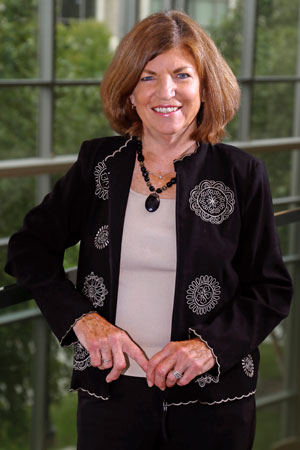
Center of Attention: Xavier’s new Center for Population Health will synergize departments
Nov 7, 2018
THE NEED: COORDINATION OF RESOURCES TO SUPPORT POPULATION HEALTH INITIATIVES AT XAVIERTHE SOLUTION: THE CENTER FOR POPULATION HEALTH
THE COST: $5 MILLION
By Ryan Clark
When Paul Gore, PhD, was hired as Dean of Xavier’s College of Professional Sciences in 2015, he inherited the work conducted the year before by interim Dean Sr. Nancy Linenkugel. One of the proposals made by the previous staff involved proposed collaborations among seemingly different academic departments.
“They were looking for ways to create a ‘we’ environment versus an ‘us and them’ environment,” Gore says. “It’s like having a department of marketing and then having a department of accounting—they’re really related. So they came up with this vision that tried to weave together some of the overlaps.”
One of the ideas that seemed to overlap many departments was something called population health. “When I arrived it was my job to advance that vision,” he says. “So we engaged in a strategic planning process and one of our pillars that emerged was to become a regional, if not national, leader in the area of population health.”
To do so, Gore created the Center for Population Health, now being led by former College of Nursing Director Sue Schmidt, which will be housed in the new Health United Building.
Communitas caught up with Gore recently to ask several questions, including how the new Center will benefit students, what his vision for it will be, and—maybe most important—just what is population health, anyway?
COMM: Can you give us a definition for population health?
GORE: It is a philosophy, or a construct, that in essence is a re-boot of our approach to health care.
Many people in our country today would argue that we don’t have a health-care industry. We have a disease-care industry. Our entire model of health care is based on curing diseases—it’s a tertiary model, after-the-fact. Further, the current industry business model reinforces fees for services provided—services that focus on disease processes. So the one thing that population health does is tell us we need to pivot, we need to think about health, wellness, well-being and thriving in a new way. The vast majority of chronic diseases in this country are preventable and we’re not focusing on prevention. We reimburse health-care professionals for treating diseases, many of which are preventable. What if the business model changed to reimbursing for health promotion and disease prevention?
Population health also recognizes that health care, under this new model, is a “team sport.” When you go into the hospital, you’ll be worked on by multiple professionals from multiple disciplines who all work together in what hopefully is an effective team environment, intercollaboratively. It’s really our job to prepare students for that future.
COMM: Tell us about your vision for the Center for Population Health.
GORE: We have a lot of faculty who are passionate about different aspects of population health. By creating the center, and resourcing it with leadership and support, we can further advance existing population health priorities and programs, identify new opportunities to expand our influence, and get students more involved in faculty efforts
COMM: You chose Sue Schmidt as the center’s director on July 1. What makes her right for this role?
GORE: Sue Schmidt was a logical choice. She had already expressed an intent to transition away from the directorship of the College of Nursing, and she’s the first person ever on this campus to say the words “population health.” She’s immersed in it. And people know her. They respect her expertise in this area. To top it off, she’s also good at getting grants. She’s perfect.
COMM: And all of this will be located in the new Health United Building. How important is it to have a home for it all?
GORE: It’s important because of the visibility the space brings. The HUB perfectly animates the pillars of population health, corporate health and collegiate health. This is interdisciplinary, multipurpose, recreation and wellness programming, good eating, primary care, mental health care, as well as all of the academic programs. For the first time ever on Xavier’s campus, they’re all in one place. There will be 1,500 students learning and interacting in health programs in the HUB and especially on the fourth floor, all from different disciplines, illustrating this concept.
COMM: How do you expect this new centralized space to impact health programs and students at Xavier?
GORE: A brand new building is going to be great when we bring prospective freshmen through. They’re going to see all this activity going on in these five academic departments, in environents in which they might find themselves working. I think we’re probably underestimating the impact that’s going to have on the number of applications. I think we can only begin to fantasize about what kinds of indirect, unofficial, vicarious learning is going to occur on that fourth floor, which is the primary space dedicated for students interacting with one another in unstructured ways. This is going to be a place where those 1,500 students can go have their coffee, have their lunch, get together and work in groups and small teams to finish a project. Then they’re going to be working together a few years later when they become professionals.
COMM: So in summary, population health is an attempt to solve a nationwide problem?
GORE: The economics are pushing this transition from primary care to population health. It’s not just us saying, “Oh we should be doing this.” The system is moving that way. It’s broken, and one possible solution is to try and relieve some of the pressure on the system by focusing on prevention.
So we’re going to try to coordinate it through the center and ride this synergy with TriHealth to see what’s possible when a non-health care, non-medical University partners with a leading regional network.
SUE SCHMIDT IS CENTER’S FIRST DIRECTOR
Her PhD is in epidemiology (the study of how to control diseases and health). Her first job was as a visiting nurse for home care. She’s raised over $10 million in grants and federal funding, the most recent of which focuses on public health. And she’s been appointed to the Ohio Patient Centered Collaborative Practice committee which is run by the Ohio Primary Care Practice Physicians in Columbus.
It’s just a few of the reasons why Sue Schmidt was the perfect choice to lead Xavier’s new Center for Population Health. Moving forward, she hopes to identify priorities and advisory groups — and she’s already working on a grant.
“It is a great opportunity to give back,” she says. “Grants, research, sharing and responding are in my future. The opportunity to collaborate across all interprofessions within our community, region, nation and perhaps globally is exciting.”
HOW TO AGE POSITIVELYEach spring, Xavier brings together over 200 students from at least five different departments for a half-day session of development experiences led by Teepa Snow, a dementia and Alzheimer’s expert.
From social work and health services administration to occupational therapy and psychology, students in interdisciplinary teams work on case studies connected to memory care. It requires them interact with one another, Gore said, just like they will in the real world.
On the same day, Xavier also hosts the Dementia Care Summit for family members, caregivers and health-care professionals outside of the University. They engage in discussion and application of strategies for improving the lives of those living with memory loss. This past year, the theme “Holistic Approaches to Enhance Life” was reflected in sessions on physical, cognitive, spiritual and environmental adjustments to improve the lives of persons living with dementia as well as their caregivers.
“We learn how we can better promote thriving in aging,” Gore says. “It’s a great example of population health in action.”
Support the Center for Population Health at xavier.edu/cpsgiving.